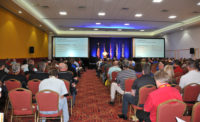
When the former Seattle Opera House opened in its latest incarnation as Marion Oliver McCaw Hall, it fulfilled the goal of preserving what is wonderful about the 75-year-old cultural center, while incorporating spectacular upgrades including excellent sightlines, expanded stage space, and an innovative HVAC system that puts a premium on comfort, acoustics, and energy efficiency.
The project is being called a transformation because while 30 percent of it comprises renovated sections of the old opera house, 70 percent is new construction. Building on the existing solid structure supports and foundation, the building owners were able to cut costs to a reasonable $125 million vs. $200 million for a new structure. In addition, the need for the resident ballet and opera companies to temporarily relocate during construction was shortened.
The opera house was renowned for its excellent acoustics. Designers were determined to not only retain that reputation, but also improve upon it with an ultra-quiet HVAC system design that had been in use in only one other performing arts center in the United States. A key element throughout the system is the use of 260,000-square-feet of a rotary duct liner chosen for its acoustical performance.

Hub Of Cultural Activities
Built as the Civic Auditorium in 1927 and upgraded cosmetically in the early 1960s as the Seattle Center Opera House, Marion Oliver McCaw Hall has undergone for its third reincarnation. It is expected to host 400 events in its first full year, an increase from 271 annual performances previously. It is home to the Pacific Northwest Ballet and the Seattle Opera.At nearly 75 years old, it was time to make major improvements to the facility. Mechanical engineering firm CDi Engineers was engaged to design a new mechanical system, the centerpiece of which is an upgraded and more responsive HVAC system. Several elements of the project, undertaken by mechanical contractor MacDonald-Miller Facility Solutions, set it apart from other performing arts center renovations.
One element was the determination to preserve “the best [acoustics] in the world for opera,” according to Speight Jenkins, general director of the Seattle Opera.
Achieving that involved a number of requirements, including the installation of a very low-velocity HVAC system lined with CertainTeed ToughGard™ R rotary duct liner with a moisture-repellent surface. Another was the strict implementation of a stringent indoor air quality specification that kept all ductwork in pristine condition at the sheet metal fabrication shop, during transportation and site storage, and during installation.
Finally, a highly unusual and innovative underfloor displacement ventilation system, de-signed for comfort and energy savings, contributed to the system’s overall excellence.

Insulation And Acoustics
MacDonald-Miller’s mechanical contract for its work at the hall is valued at $13 million, much of which is devoted to the new HVAC system, which supplies 250,000 cfm of air. Low-velocity air is supplied to the acoustically sensitive spaces through sheet metal rectangular duct that ranges in size from 6 by 6 inches to huge sections measuring up to 12 feet wide. The duct is sized larger than normal in some cases in order to meet the restrictive allowable noise level.The duct liner chosen for the application, 1-inch, 1-1/2-pound density ToughGard R, is designed to absorb unwanted crosstalk, equipment, and air rush noise. The rotary-based fiberglass liner contains Enhanced Surface, a new moisture-resistant improvement designed to reduce the potential for microbial growth. The antimicrobial properties are intended to protect only the liner.

Because the owner was very concerned about maintaining the high IAQ of the entire HVAC system, an IAQ specialist was hired and immediately implemented an IAQ specification that may be a sign of a new industry trend. Operating under very stringent rules, MacDonald-Miller employees took precautions to protect every piece of lined ductwork from moisture and other contaminants.

European HVAC System
CDi’s underfloor displacement ventilation system sets it apart from the typical American HVAC system design. In traditional performance halls, air is supplied overhead and air returns are vented through grilles located either under the seats or positioned low on the side wall. With the McCaw Hall system, conditioned air is supplied from underneath the seats.Eight-inch supply air diffusers are spaced at approximately every other seat, allowing a relatively small amount of air to pass at a very low velocity. This is to keep the moving air noise at a minimum while keeping patrons comfortable. A cushion of this conditioned air remains at floor level. The body heat of patrons induces a continuous upward convective airflow, drawing the pool of conditioned air past their bodies.
Only the zone within 5 feet of the floor needs to maintain comfortable temperatures. The warm air ascends to the ceiling and is then returned to the central system.

With an innovative HVAC system design, IAQ integrity, and an acoustically superior environment for performances of all kinds, the new Marion Oliver McCaw Hall may not only become a destination for area residents and tourists, but may also be a nice place for today’s HVAC system designers to visit.
Publication date: 09/29/2003





